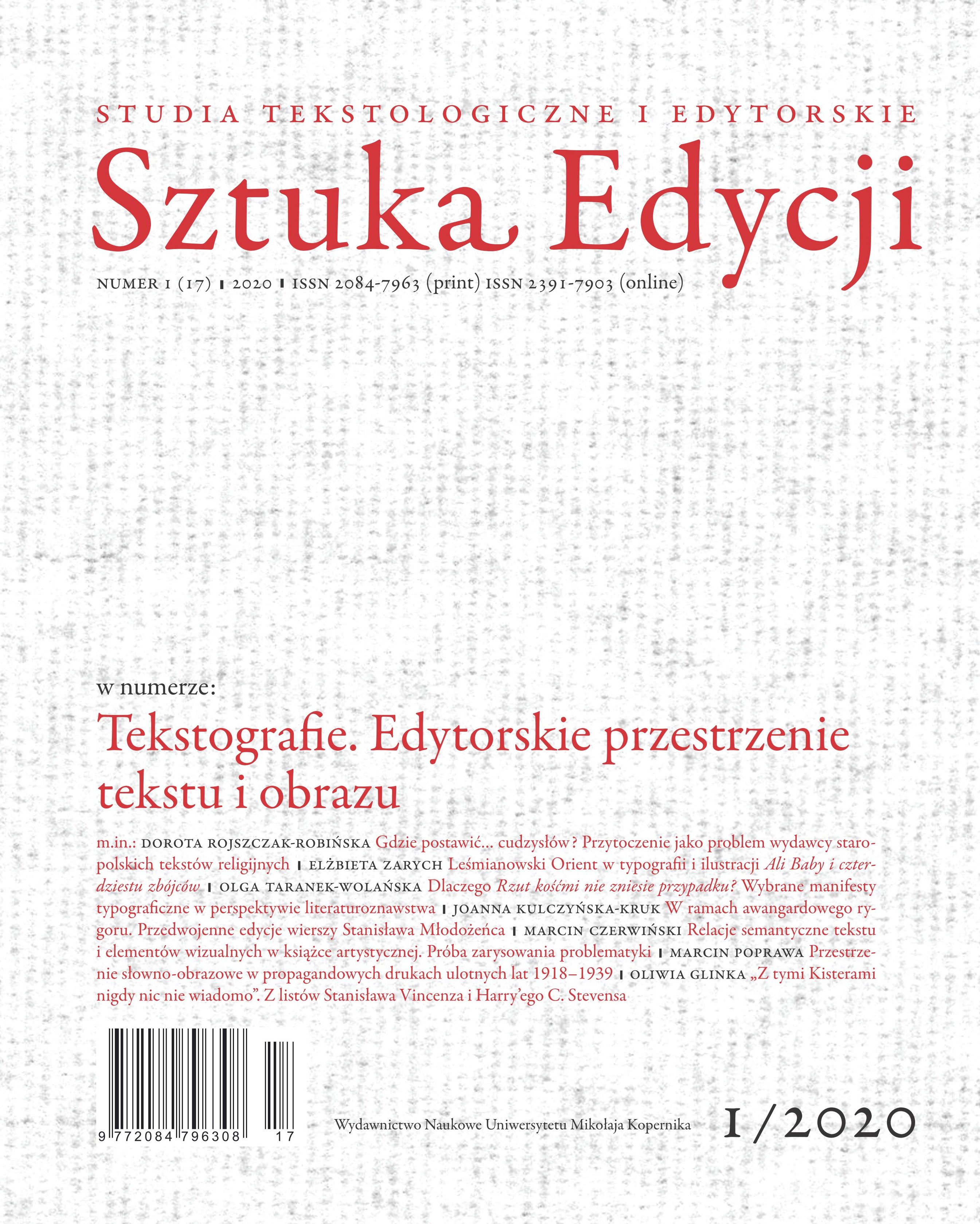Leśmian’s Orient in the typography and illustration of "Ali Baba and the forty thieves"
DOI:
https://doi.org/10.12775/SE.2020.0005Keywords
Bolesław Leśmian, Klechdy sezamowe, Ali Baba and the forty thieves, illustrated book, illustration, Elżbieta Gaudasińska, Jan Lenica, Edmund DulacAbstract
The collection entitled Klechdy sezamowe by Bolesław Leśmian, written by the poet at the publisher’s request, was published in 1912. Since that time, the tale Ali Baba i czterdziestu zbójców has been published in Poland with the illustrations by eleven different illustrators (such as E. Dulac, J. Lenica or E. Gaudasińska), eight times in a volume, and in three separate editions; the re-editions often differ from one another. Originally, ready illustrations of the French artist were used, with the text and pictures being fitted to one another, in the next ones artists would interpret the already known composition. The article is devoted to tracing the illustrated editions of that tale, studying to what extent they are rooted in the culture of Near East and Persia, the popular fairy tale plot of Ali Baba and the forty thieves, and to what extent they reflect Leśmian’s philosophical thought and vision. It is accompanied by numerous questions about inspirations and imagery of both the poet and illustrators and publishers, as well as creators’ interpretation and understanding of Leśmian’s edition, as well as the goal of individual publications and the image of their potential recipients. When perceiving illustration as an intersemiotic translation, a question was asked about the shape of the tale captured in pictures, reasons and elements of that translation, the selection of graphical solutions, technique or style. The article also contains issues related to rooting the style of a given illustrator, the epoch and contemporary publishing market. It is important to look from the semantic perspective to various accounts of words and pictures, analyze the elements of text selected by particular illustrators, their concretization, supplements, decorum, dominants, hierarchy of elements etc., as well as their loyalty towards text, since of all those elements each of the illustrators creates and Oriental and Leśmian’s space of thought, word and image.
References
Buras J. St., 1996, Bibliographie deutscher Literatur in polnischer Übersetzung. Vom 16. Jahrhundert bis 1994, Wiesbaden.
Chraïbi A., 2007, Galland’s “Ali Baba” and Other Arabic Versions, w: The Arabian Nights in Transnational Perspective, ed. U. Marzolp, Detroit.
Czabanowska-Wróbel A., 1996, Baśń jako światopogląd. Baśń i baśniowość w twórczości Leśmiana, w: eadem, Baśń w literaturze Młodej Polski, Kraków.
Czabanowska-Wróbel A., 2009, Złotnik i śpiewak. Poezja Leopolda Staffa i Bolesława Leśmiana w kręgu modernizmu, Kraków.
Dąmbska-Prokop U., 2000, Mała encyklopedia przekładoznawstwa, Częstochowa.
Diduszko H., 2007, Elżbieta Gaudasińska. Pisarze i ilustratorzy książek dziecięcych, „Świat Książki Dziecięcej”, nr 3.
Dunin J., 2003, Okładka i obwoluta jako komunikat, w: Sztuka książki. Historia, teoria, praktyka, pod red. M. Komzy, Wrocław.
Górski T. P., 2018, Bolesław Leśmian jako tłumacz, „Rocznik Przekładoznawczy”, nr 13, s. 77–78.
Haupt P., 1927, “Open Sesame”, w: Beiträge zur assyriologie und semitischen Sprachwissenschaft, pod red. F. Delitzscha i P. Haupta, t. 10, cz. 2, Lipsk.
Hofstätter H. H., 1987, Jugendstil – Graphik und Druckkunst, Salzburg–Baden-Baden.
Kaim B., 1996, Sztuka starożytnego Iranu, Warszawa.
Lea R., 2018, How Aladdin’s Story Was Forged in Aleppo and Versailles, „The Guardian” 2.11.
Leszczyński G., 2003, Literatura i książka dziecięca. Słowo – obiegi – konteksty, Warszawa.
Leszczyński G., 2003, Wpływ grafiki francuskiej na teksty baśni Leśmiana, w: idem, Literatura i książka dziecięca. Słowo – obiegi – konteksty, Warszawa.
Leszczyński G., 2015, Wielkie małe książki, Poznań.
MacDonald D. B., 1910, Ali baba and the Forty Thieves’ in Arabic from a Bodleian MS, „Journal of the Royal Asiatic Society of Great Britain & Ireland”, April, s. 327–386.
Mahdi M. S., 1995, The Thousand and One Nights, Leiden–New York–Köln.
Meyer S. E., 2011, An Edmund Dulac Treasury: 116 Color Illustrations, New York.
Mortkowicz-Olczakowa H., 1962, Pod znakiem kłoska, Warszawa.
Orientalische Bibliothek: oder Universalwörterbuch, welches alles enthält was zur das Kenntniss des Orients notwendig ist, 1787, Verf. B. d’Herbelot, Bd. 2, Halle.
Orientalische Bibliothek: oder Universalwörterbuch, welches alles enthält was zur das Kenntniss des Orients notwendig ist, 1785, Verf. B. d’Herbelot, Bd. 1, Halle.
Pereira N. M., 2008, Book Illustration as (Intersemiotic) Translation: Pictures Translating Words, „Meta”, No. 1, Vol. 53: Le verbal, le visuel, le traducteur, s. 104–105.
Petrozolin-Skowrońska B., 2007, Elżbieta Gaudasińska, „Wydawca”, nr ½.
Staniów B., 2013, Przekłady literatur obcych w latach 1945–1989, w: Literatura dla dzieci i młodzieży (1945–1989), t. 3, pod red. K. Heska-Kwaśniewicz, K. Tałuć, Katowice.
Szcześniak K., 2011, Okładka i obwoluta książki jako przedmiot badań interdyscyplinarnych, „Toruńskie Studia Bibliologiczne”, nr 2.
The Arts of Persia, 1989, ed. R. W. Ferrier, New Haven–London.
Uljasz A., 2016, Świat orientu w baśniach Bolesława Leśmiana. Wizja pisarza, odbiór czytelniczy i recepcja teatralna, „Annales Universitatis Paedagogicae Cracoviensis. Studia ad Bibliothecarum Scientiam Pertinentia” 14, Folia 211.
Venuti L., 1995, Translator’s Invisibility: A History of Translation, London.
Walizka Leśmiana. Losy ocalonych rękopisów, 2019, oprac. i posł. D. Pachocki, Lublin.
Wawryk J., 2013, Wokół Leśmianowskich baśni dla dzieci, Wrocław.
Welch A., 1995, Şafawids V. Arts and architecture, w: C. E. Bosworth et al., The Encyclopaedia of Islam. New Edition, Vol. 8, Leiden.
White C., 1976, Edmund Dulac, New York.
Wincencjusz-Patyna A., 2008, Stacja ilustracja. Polska ilustracja książkowa 1950–1980, Wrocław.
Wróblewska V., Polska bajka ludowa. Słownik, online: https://bajka.umk.pl/slownik/lista-hasel/haslo/?id=235.
Wysłouch S., 1994, Literatura a sztuki wizualne, Warszawa.
Zarych E., 1999, Postacie kalek w utworach Bolesława Leśmiana – zwycięstwo ciała czy ducha?, „Teksty Drugie”, nr 6.
Zarych E., Wydawnictwa dla dzieci oraz Ilustracje dla dzieci na: www.encyklopediadziecinstwa.pl.
Zimand R., 1971, Preliminaria do klechd Leśmiana, w: Studia o Leśmianie, pod red. M. Głowińskiego i J. Sławińskiego, Warszawa.
Downloads
Published
How to Cite
Issue
Section
Stats
Number of views and downloads: 1128
Number of citations: 0



